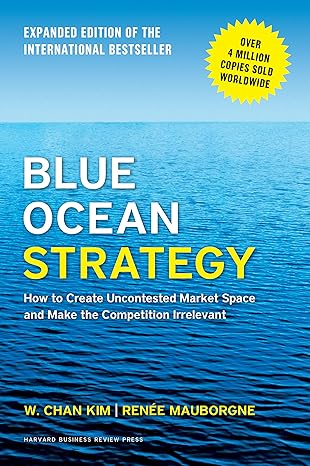Blue Ocean Strategy challenges businesses to shift their mindset from competing in saturated markets to creating new opportunities through value innovation. By systematically eliminating, reducing, raising, and creating market factors, businesses can redefine industries, achieve differentiation, and make competition irrelevant.
Frameworks and Strategies
1. The Concept of Blue Oceans vs. Red Oceans
- Importance: Red oceans represent existing markets with intense competition, while blue oceans are untapped opportunities where businesses can thrive without direct rivals.
- Steps to Implementation:
- Identify saturated and hyper-competitive red ocean markets.
- Look for unmet customer needs or overlooked opportunities.
- Innovate to create entirely new demand.
- Checklist:
- Are you stuck competing in a red ocean market?
- Have you identified potential blue ocean opportunities?
- Is your strategy focused on creating, not competing?
2. The Value Innovation Framework
- Importance: Value innovation is the cornerstone of blue ocean strategy. It involves simultaneously pursuing differentiation and cost savings to deliver high value to customers.
- Steps to Implementation:
- Focus on what customers truly value and eliminate unnecessary features.
- Reduce costs by eliminating or reducing non-essential elements.
- Enhance or create new features that redefine the customer experience.
- Checklist:
- Have you identified customer pain points to address?
- Are you balancing innovation with cost efficiency?
- Does your offering stand out as uniquely valuable?
3. The Four Actions Framework (Eliminate-Reduce-Raise-Create Grid)
- Importance: This framework helps businesses systematically evaluate how to innovate by challenging industry norms.
- Steps to Implementation:
- Eliminate: Remove factors that customers no longer value.
- Reduce: Minimize aspects that are over-served.
- Raise: Enhance elements that are under-served.
- Create: Develop entirely new features that add significant value.
- Checklist:
- Have you eliminated non-essential features or services?
- Are you reducing costs on over-delivered aspects?
- Have you identified areas to raise or create new value?
4. The Strategy Canvas
- Importance: The strategy canvas is a visual tool that helps businesses compare their offerings against competitors and identify opportunities for differentiation.
- Steps to Implementation:
- Plot current industry practices and key factors customers value.
- Identify areas of oversaturation and gaps in the market.
- Use the canvas to design a unique value proposition.
- Checklist:
- Have you mapped out your industry’s key factors?
- Can you see areas of saturation or neglect?
- Does your value curve differ significantly from competitors?
5. Overcoming Organizational and Market Hurdles
- Importance: Implementing a blue ocean strategy requires overcoming challenges like resistance to change, execution difficulties, and scaling new ideas.
- Steps to Implementation:
- Clearly communicate the benefits of the strategy to stakeholders.
- Start small with pilot initiatives to demonstrate success.
- Continuously refine and scale successful innovations.
- Checklist:
- Have you addressed internal resistance to change?
- Are you testing innovations before scaling?
- Do you have a clear plan for execution and scaling?
Final Checklist
- Identify red ocean markets where competition is fierce.
- Explore unmet customer needs to find potential blue ocean opportunities.
- Use the Four Actions Framework to innovate effectively.
- Design a compelling strategy canvas to differentiate your offering.
- Overcome organizational challenges to execute and scale your strategy.
https://amzn.to/3YtD1Cq
